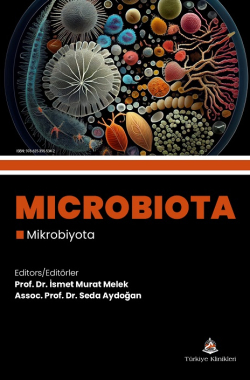DEPRESSION AND MICROBIOTA
Nurbanu Toprakoğlu Tavukçu1
Mehmet Numan Çam2
Mert Şenol3
1Ankara Etlik City Hospital, Department of Neurology, Ankara, Türkiye
2Ankara Etlik City Hospital, Department of Neurology, Ankara, Türkiye
3Ankara Etlik City Hospital, Department of Neurology, Ankara, Türkiye
Toprakoğlu Tavukçu N, Çam MN, Şenol M. Depression and Microbiota. Melek İM, Aydoğan S, eds. Microbiota. 1st ed. Ankara: Türkiye Klinikleri; 2025. p.135-142.
ABSTRACT
Depression is a neuropsychiatric disorder characterized by anhedonia, loss of motivation, feeling worthless, difficulty getting out of bed and may lead to suicide. It can lead to school dropout and decreased productivity in social and professional life. 280 million people worldwide suffer from depression. It is ranked 4th in the DALY ranking. The etiopathogenesis of depression has not been clearly elucidated. Changes in the gut microbiota and the Brain-Gut axis have recently been proposed as a new paradigm in the etiopathogenesis of the disease. This axis consists of the brain, pituitary, vagus, enterochromaffin cells in the gut and the gut microbiome. This axis is also in bidirectional communication. Four main pathways have been identified in the brain-gut-microbiome axis. The first of these pathways is realized by direct neural stimulation of bowel movements and the exchange of neuroendocrine hormones. In response to stress, the brain-pituitary-adrenal gland axis activates and increases the secretion of stress hormones epinephrine and norepinephrine. This increase leads to changes in the gut microbiome, and because of these changes, the contents of the chymus begin to be digested differently. The second pathway is the free circulation of essential amino acids such as tryptophan produced by commensal bacteria in the gut. Tryptophan is a precursor of serotonin. 80% of serotonin is produced in the distal gastrointestinal tract. Serotonin is the most important molecule shown so far in the pathogenesis of depression. The third pathway is the Vagus nerve and efferent and afferent stimuli. The vagus nerve accelerates the movements of the intestinal passage by direct stimulation. This stimulation is in balance with the sympathetic system. Indirectly, studies have shown that it generates a response in the central nervous system like the response of nicotinic acetyl choline receptors that generate an anti-inflammatory response. The fourth is the inflammatory response of the body to amino acids and short-chain fatty acids formed in the gut microbiome. Increases or decreases in tryptophan and short-chain fatty acids, depending on the proportion of commensal bacteria, change the molecules circulating freely in the blood. For example, an increase in tryptophan causes an increase in kynurenine, which shows an inflammatory response. As we have briefly summarized, it is an undeniable fact that new studies will be forthcoming due to the intricate and complex structure of this system.
Keywords: Depression; Brain-gut axis; Gastrointestinal microbiome; Microbiota; Mycobiome; Tryptophan; Serotonin; Kynurenine
Kaynak Göster
Referanslar
- Roberts LW, ed. The American Psychiatric Association Publishing Textbook of Psychiatry. Seventh edition. American Psychiatric Association Publishing; 2019. [Crossref]
- Ferrari AJ, Charlson FJ, Norman RE, et al. Burden of Depressive Disorders by Country, Sex, Age, and Year: Findings from the Global Burden of Disease Study 2010. Hay PJ, ed. PLoS Med. 2013;10(11):e1001547. [Crossref] [PubMed] [PMC]
- Góralczyk-Bińkowska A, Szmajda-Krygier D, Kozłowska E. The Microbiota-Gut-Brain Axis in Psychiatric Disorders.IJMS. 2022;23(19):11245. [Crossref] [PubMed] [PMC]
- Chang L, Wei Y, Hashimoto K. Brain-gut-microbiota axis in depression: A historical overview and future directions. Brain Research Bulletin. 2022;182:44-56. [Crossref] [PubMed]
- Mayer EA, Nance K, Chen S. The Gut-Brain Axis. Annu Rev Med. 2022;73(1):439-453. [Crossref] [PubMed]
- Martin CR, Osadchiy V, Kalani A, Mayer EA. The Brain-Gut-Microbiome Axis. Cellular and Molecular Gastroenterology and Hepatology. 2018;6(2):133-148. [Crossref] [PubMed] [PMC]
- Tian P, Chen Y, Zhu H, et al. Bifidobacterium breve CCFM1025 attenuates major depression disorder via regulating gut microbiome and tryptophan metabolism: A randomized clinical trial. Brain, Behavior, and Immunity. 2022;100:233-241. [Crossref] [PubMed]
- Roth W, Zadeh K, Vekariya R, Ge Y, Mohamadzadeh M. Tryptophan Metabolism and Gut-Brain Homeostasis. IJMS. 2021;22(6):2973. [Crossref] [PubMed] [PMC]
- Varesi A, Campagnoli LIM, Chirumbolo S, et al. The brain-gut-microbiota interplay in depression: A key to design innovative therapeutic approaches. Pharmacological Research. 2023;192:106799. [Crossref] [PubMed]
- Asano Y, Hiramoto T, Nishino R, et al. Critical role of gut microbiota in the production of biologically active, free catecholamines in the gut lumen of mice. American Journal of Physiology-Gastrointestinal and Liver Physiology. 2012;303(11):G1288-G1295. [Crossref] [PubMed]
- Chudzik A, Orzyłowska A, Rola R, Stanisz GJ. Probiotics, Prebiotics and Postbiotics on Mitigation of Depression Symptoms: Modulation of the Brain-Gut-Microbiome Axis. Biomolecules. 2021;11(7):1000. [Crossref] [PubMed] [PMC]
- Bear TLK, Dalziel JE, Coad J, Roy NC, Butts CA, Gopal PK. The Role of the Gut Microbiota in Dietary Interventions for Depression and Anxiety. Advances in Nutrition. 2020;11(4):890-907. [Crossref] [PubMed] [PMC]
- Pu Y, Tan Y, Qu Y, et al. A role of the subdiaphragmatic vagus nerve in depression-like phenotypes in mice after fecal microbiota transplantation from Chrna7 knock-out mice with depression-like phenotypes. Brain, Behavior, and Immunity. 2021;94:318-326. [Crossref] [PubMed]
- Zhang J chun, Yao W, Ren Q, et al. Depression-like phenotype by deletion of α7 nicotinic acetylcholine receptor: Role of BDNF-TrkB in nucleus accumbens. Sci Rep. 2016;6(1). [Crossref] [PubMed] [PMC]
- Mohammad-Zadeh LF, Moses L, Gwaltney-Brant SM. Serotonin: a review. Vet Pharm & Therapeutics. 2008;31(3):187-199. [Crossref] [PubMed]
- Liu L, Wang H, Chen X, Zhang Y, Zhang H, Xie P. Gut microbiota and its metabolites in depression: from pathogenesis to treatment. eBioMedicine. 2023;90:104527. [Crossref] [PubMed] [PMC]
- Demirci M, Bahar Tokman H, Taner Z, et al. Bacteroidetes and Firmicutes levels in gut microbiota and effects of hosts TLR2/TLR4 gene expression levels in adult type 1 diabetes patients in Istanbul, Turkey. Journal of Diabetes and its Complications. 2020;34(2):107449. [Crossref] [PubMed]
- Varesi A, Campagnoli LIM, Chirumbolo S, et al. The brain-gut-microbiota interplay in depression: A key to design innovative therapeutic approaches. Pharmacological Research. 2023;192:106799. [Crossref] [PubMed]

